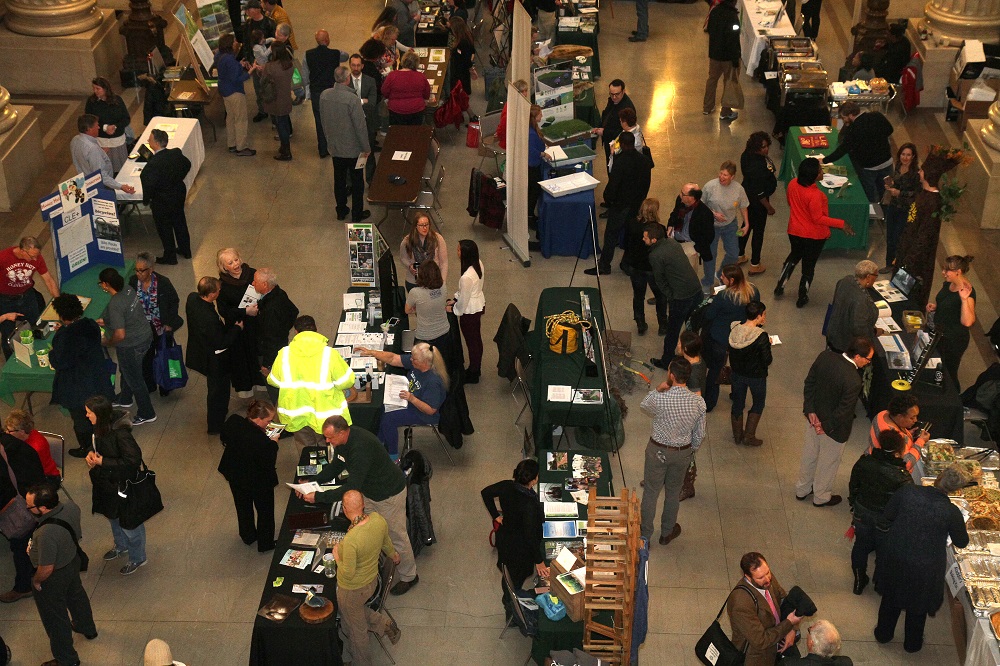
Fri 1/26 @ 11AM-2PM
At the heart of Cleveland’s Sustainable Cleveland 2019 initiative is the creation of viable neighborhoods with thriving businesses and a flourishing natural environment. That’s why it shouldn’t come as a surprise that this year the city is designating 2018 as the Year of Vital Neighborhoods.
On January 26 in the City Hall rotunda there’s a Sustainable Cleveland 2019 kick-off event — free anodyne to the public — featuring more than 25 local leaders helping transform communities. This year’s efforts highlight local resources to help individuals and neighborhoods become more sustainable and learn about funding opportunities for neighborhood sustainability projects, as well as gain information to save money, reduce the carbon footprint, improve health and connect with neighbors.
CoolCleveland talked to Mayor’s Office of Sustainability director Matt Gray about this year’s focus and the initiative’s impact in the community.
CoolCleveland: Can you talk about 2018 being the Year of Vital Neighborhoods?
Matt Gray: It’s part of the Sustainable Cleveland 2019 initiative that Mayor Frank Jackson launched in 2009. A 10-year initiative to really move toward this green city on a blue lake. Sustainability is a big topic. It’s kind of hard to get your arms around it at times. The idea was to really focus on different sustainability topics every year so up until this point it’s been more on the areas where you can take action on a specific sector. For example, the first year was energy efficiency, then we moved on to things like local food, zero waste and sustainable transportation. Last year was the Year of Vibrant Green Space. This year we’re really excited it’s the year of Vital Neighborhoods. So how do you bring together all of these sustainability topics at the neighborhood level?
CC: With that in mind, how do you plan on reaching into the neighborhoods?
MG: Some of that is still in development. It’s going to start at the kick-off event to get a first look at all of those organizations that are really supporting neighborhoods around Cleveland. That’s really the focus of this event. Residents can learn from these organizations that have tons of experience working in neighborhoods on specific topics. We’ll have Western Reserve Land Conservancy talking about how neighborhoods and residents can get involved in trees and green space. Similarly, the Cuyahoga Land Bank will be there from that perspective. We’ll have folks like Cleveland Department of Public Health talking about lead abatement and improving the air quality.
CC: Is it safe to say the Year of Vital Neighborhoods is a culmination of previous annual efforts?
MG: I think that’s right. This is almost beginning that culmination process. So really, 2019 will be the culmination itself. Specifically, we’re looking forward to June 22, 2019, which will be the 50th anniversary of the Cuyahoga River burning. That will be kind of the milestone point for us to really tell our story. It’s kind of all leading into that. This year we’re focusing in on neighborhoods, but I think this work will of course delve into next year as well as we move into that anniversary.
CC: What kind of impact has Sustainable Cleveland 2019 initiative made around the community?
MG: As a whole, we’ve certainly made progress since 2009. Obviously, there’s a lot more to do, but we do have proof we’re headed in the right direction. Water quality had markedly improved. There’s the health of the fish in the river, as well as Lake Erie. We’re dealing with algae blooms, but certainly the river water quality has significantly improved. Economic activity and recreation associated with the river continues to increase. Air quality has improved, which is certainly important for those with asthma and other vulnerable populations. We have a long way to go, but we’ve seen improvement. We’d made significant progress on offshore wind. That project is still on pace within the next three years to be completed. We’ve seen just in the last four years 60 miles of bike infrastructure installed. Of course, we’re moving towards protected bike infrastructure. I’d say our local food economy is still nationally known compared to other cities. One metric we look at to kind of bring a lot of this together is our carbon footprint. We’ve seen a decrease as a city since 2010 when we first started measuring that.
CC: Looking back, what kind of challenges has the campaign faced over the years?
MG: Certainly, I think the biggest hurdle is culture change. Also, to reach the entire community, which I think is still a hurdle to a large degree, but we really hope these next couple of years to make significant inroads in that. We have a large choir here in Cleveland on sustainability, I think larger than most cities, but how do you expand beyond that choir to really make transformative change?
CC: Finally, what’s planned for next year regarding the Sustainable Cleveland 2019 initiative?
MG: We’re getting very excited. We’re going to be hosting a 2019 steering committee soon. It’s going to bring together a lot of leaders in the community. It’s really that June 22 weekend. It could be the largest sustainability event in the country that year. There’s potential there. The Cuyahoga River burning isn’t just a Cleveland story, it’s an international story. I think it resonates for a lot of people. So if we can show in Cleveland with local policy and local leaders connected with good federal policy, you can make significant change, I think that message will resonate.
Cleveland, OH 44114